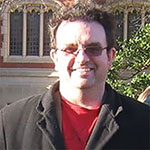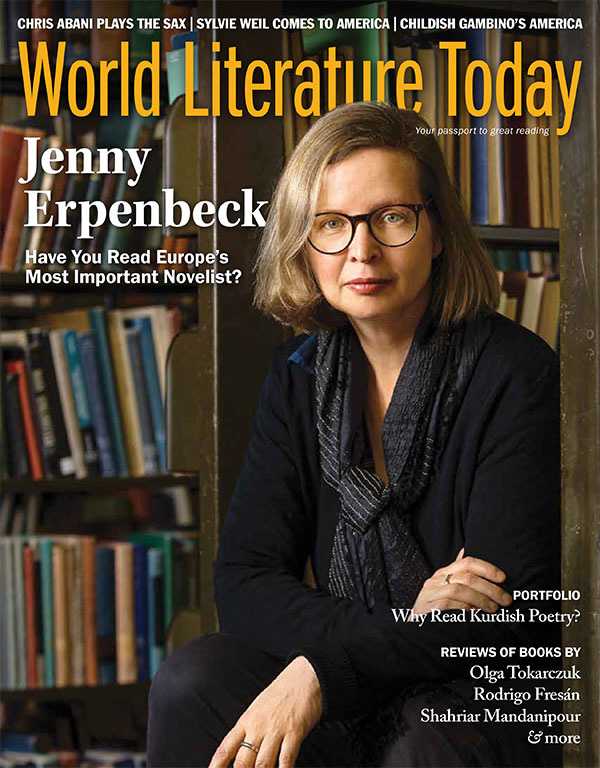Vectors, Vanishing Points, and Vicissitudes in the Works of Jenny Erpenbeck

Life for Jenny Erpenbeck’s characters is a vector, a movement through time and space, in which both temporal and spatial circumstances impinge on the individual’s trajectory.
Jenny Erpenbeck’s last three novels, Visitation (Heimsuchung, 2008), The End of Days (Aller Tage Abend, 2012), and Go, Went, Gone (Gehen, Ging, Gegangen, 2015), range so widely in terms of geography and history that at first glance it seems difficult to discern a common thematic thread. Visitation follows a single plot of lakeside land outside Berlin from the Ice Age to the post-reunification era. The End of Days presents a protagonist who lives five different lives and dies five different deaths in various locales and periods, encompassing turn-of-the-century Galicia in the periphery of the Austro-Hungarian Empire, post–World War I Vienna, Stalinist Russia, East Germany in the 1960s, and the Berlin Republic of the 1990s. While Go, Went, Gone offers a fairly sedentary protagonist and a strictly contemporary setting, here it is the world that comes to Erpenbeck’s Berlin in the form of refugees from several African countries, including Libya, Nigeria, Mali, Niger, and Ghana. And yet it is precisely this movement through time and/or space—the vectors described not only by the plots of her novels but by individual characters—that represents Erpenbeck’s central thematic interest.
In book 2 of Jenny Erpenbeck’s 2012 novel, The End of Days, the protagonist is an eighteen-year-old struggling with her family to survive amid the deprivation and disease of Vienna after the First World War. Erpenbeck makes us privy to the musings of both the protagonist’s mother and father as they consider the relationship between the human body and its environment during this period of impoverishment and starvation. For the mother, the connection is personal and corporeal: hiking up her skirt to survey her legs in the mirror, she considers how her bodily decline reflects that of a city which threatens to be overrun by the encroaching countryside: “After four years of war, Vienna had gone to seed and so had she.” While the mother thus focuses on the influence of geography and space on the human body, the father contemplates in a more abstract manner the impingement of historical events on the physiognomy of the population enduring them, “how processes, circumstances, or events of a general nature—such as war, famine, or even a civil servant’s salary that fails to increase with the galloping inflation—can infiltrate a private face.” At the end of this second book, the contingencies of both space and time, geography and history, contribute to their daughter’s decision to arrange a suicide pact with a young man she has just met. Trying to trace the trajectory of this tragedy, the father repeatedly asks, “What in the good Lord God’s name did we do on Sunday evening?”—the day his daughter committed suicide.
In all these texts, Erpenbeck goes further, showing not only the influence of spatial and temporal vicissitudes on human destinies but also their influence on the distinct trajectories of human-made objects and the natural world.
Given that the novel repeatedly provides the coordinates of longitude and latitude for the protagonist’s various deaths, this scenario suggests that life for Erpenbeck is a vector, a movement through time and space, in which both temporal and spatial circumstances impinge on the individual’s trajectory. This preoccupation with vectors and vanishing points, the trajectories and teleologies of her characters’ lives, pervades all three of Erpenbeck’s most recent novels. But in all these texts, Erpenbeck goes further, showing not only the influence of spatial and temporal vicissitudes on human destinies but also their influence on the distinct trajectories of human-made objects and the natural world.
In considering the 2008 novel Visitation, the radicalism of Erpenbeck’s vision can best be appreciated if we contrast this text with the nineteenth- and early twentieth-century tradition of the realist family saga. This genre ties familial inheritance to particular places, novelistic plots to plots of land. Even if the mode of succession is unexpected and a little bumpy, as in Jane Austen’s Mansfield Park (1814), we can rest assured that the estate will eventually fall to the children of the most morally righteous family member, the persecuted yet patient Fanny Price. Even if the family itself falls into a terminal decline, as in Thomas Mann’s Buddenbrooks (1901), we can rest assured that that single lineage will form the thematic core of the text and that its demise will be presented as tragic. Instead, Erpenbeck presents a novel of disinheritance, discontinuity, and dissolution in which various families’ attempts to own and pass on the same plot of lakeside land near Berlin are thwarted by forces both from without and within: a family estate in the nineteenth century is lost when the youngest daughter succumbs to insanity; a Jewish family has its home expropriated by the Nazis, and all the family members who remain in Germany are murdered in the Holocaust; the German architect who exploits this expropriation to take over the Jews’ home is in turn forced to flee to the West when he falls into political disfavor in the GDR; a writer who went into exile during the Third Reich and returned to East Germany leases part of the property to a doctor with political influence who alters it radically and with apparent impunity; an expellee from Poland stays as a guest of the writer and contemplates all she has lost on her journey; subletters and even squatters in the post-reunification era are expelled from a place they consider an earthly paradise, and the property is ultimately demolished. Any attempt to hold and pass on the land seems as futile as attempting to resist this idyll’s hold on the individual imagination.
Indeed, not only the central parcel of land, which we follow from the Ice Age to the present day, but all objects that we as human beings attempt to possess seem destined in Erpenbeck’s world to slip from our grasp. According to the Polish expellee, this is the natural order of things and people: whether during peacetime or as postwar refugees, it is either poverty or the front that pushes people forward like dominoes, with one person sleeping in another’s bed, or using his pots and pans, or eating his provisions. Thus the vectors described by objects seem to intersect only briefly with the lives of their would-be owners.
The only character that seems to escape from this ineluctable law of loss is the mythopoetic Gardener, a perennial figure who in regular interludes throughout the novel tends to the landscape rather than seeking dominion over it. And yet even this figure, who must be well over a hundred years in age by the end, ultimately disappears. He seems to return to the realm of folklore from which he came, a trajectory that suggests that a perfect, nonacquisitive, and nonexploitative symbiosis between humankind and nature is merely the stuff of legend.
Erpenbeck’s singular vision of the separate trajectories described by people, objects, and the natural world clearly has political, economic, social, cultural, and ecological ramifications.
The natural world is not the focus of The End of Days, but what Hugo von Hofmannsthal and Walter Benjamin termed the mute language or languages of objects most definitely is.* The novel presents five deaths for the protagonist, only to annul and withdraw four of them during the intermezzi, as small changes in circumstances produce different outcomes. As we read the first intermezzo, we become aware as readers of the fundamentally provisional nature of the narrative being presented to us, which could be canceled out at a moment’s notice. Thus in a sense it falls to the much less mutable realm of objects to provide a through line, an overall trajectory to this radically disrupted and disruptive narrative. In this regard the major leitmotif is the collected works of Goethe, which the two preceding generations of the protagonist carry with them as both heirloom and totem. We first encounter these volumes when the spine is scuffed by a stone thrown by an anti-Semitic Polish mob that attacks the home of the protagonist’s grandmother and grandfather in Galicia during a pogrom and hacks her grandfather to pieces. These volumes thus stand on one hand for the assimilationist impulse that leads the grandmother to marry her daughter to a Gentile in the hope of better protecting her family, while on the other they bear the sign of this project’s ultimate failure in the murderous response of the majority culture. Brought by the grandmother to Vienna when the family relocates to the imperial and Austro-German metropole, the volumes eventually turn up in an antiques store in Vienna, where the protagonist’s son, Sasha, glances at them as a potential gift for his mother before deciding on a plate depicting the Austrian and Prussian emperors, Franz Josef and Wilhelm II, instead. Oblivious to both the significance of these volumes and to his Jewish heritage, Sasha’s response to these objects indicates that his grandmother’s assimilationist ambition has succeeded only in obliterating his knowledge of his family’s Judaic ancestry, while utterly failing to protect the previous generations from the Holocaust.
The poignancy of this near miss between the family’s heirloom and the grandson indicates that the vectors of people and objects merely intersect in Erpenbeck’s world, rather than coinciding. But she goes further. In the only interlude outside the intermezzi, Erpenbeck disrupts the chronological flow to fill in the missing history of these books. We learn how the protagonist’s grandmother had her property confiscated by the Nazis before she was deported to a death camp in the East. We learn about the Aryan family that bought the set and how they, in stark contrast to the disruption visited upon the original owners, passed it down through a couple of generations of peaceful Aryan lives and peaceful Aryan deaths. Yet before these last points on this set’s trajectory, a short vignette indicates the limits of such expropriation. Talking to his Jewish assistant, Chaim Safir, the manager of the depot of confiscated Jewish property, Herr Gschwandnter, takes one look at Goethe’s collected works, grins, and declaims, “To be or not to be!” Clearly embarrassed, Chaim Safir cannot meet his boss’s gaze. In this way Erpenbeck shows not only that ownership of objects is very far removed from cultural knowledge of their significance but also that the majority German culture which is the target of the Jewish family’s assimilationist desire is oblivious to its own legacy.
If Visitation is a novel of dissolution and The End of Days one of oblivion, in both the annihilation of the family and the obliteration of their Jewish heritage, then Go, Went, Gone from 2015 is a novel of intersection. The German protagonist Richard crosses paths with a group of refugees and becomes more and more involved in their lives and struggles. Erpenbeck makes this motif of intersection explicit in an early scene in chapter 8, in which Richard observes young German natives, who “refuse to believe that the world is an idyllic place and want everything to change,” and the refugees, who “are trying to gain admittance to this world that appears to them convincingly idyllic.” Erpenbeck writes, “Here on the square, these two forms of wishing and hoping cross paths, there’s an overlap between them, but this silent observer [i.e., Richard] doubts that the overlap is large.” This encounter takes place in Kreuzberg, a Berlin neighborhood that bears in the word “Kreuz,” or cross, the sign of this intersection of trajectories.
The cross of “Kreuzberg” is of course also the symbol of Christianity, and Richard bears the name of the English king most readily associated with the Crusades, Richard I or Lionheart. It is therefore fitting that Richard, despite his own atheism, should explain German Christmas traditions to his Nigerian interlocutor, Rashid, and thus attempt in a small way to transcend the millennial conflict between Christianity and Islam. Here the consonance of the names “Richard” and “Rashid” suggests that the cultural gulf between the two men is not insurmountable. Indeed, in the course of the novel Richard comes to understand that the overlap between himself and the refugees he comes to call friends can be greatly expanded, and that the intersection and interaction between self and other can lead to greater self-knowledge.
In conclusion, Erpenbeck’s singular vision of the separate trajectories described by people, objects, and the natural world clearly has political, economic, social, cultural, and ecological ramifications. Above all, it seems to stem from an experience rooted in the GDR and the post–1989 Wende, in the knowledge that the capitalist notion of ownership is a learned behavior, rather than simply the ambient ideology in which we all swim. This suspicion is borne out by Erpenbeck’s publication in 2009 of a collection of essays entitled Dinge, die verschwinden (Things that disappear), in which she eulogizes not only the building that housed the Palast der Republik, the East German Parliament, but also the empty spaces and wasteland of the former East Berlin that have been built upon since reunification. At a time when the predations of global capital threaten the existence of humanity, we ignore at our peril her vision of the inevitable vectors in our lives that render all human possessions fleeting and transitory.
University of Oklahoma
* Hugo von Hofmannsthal, “Ein Brief” (A Letter), in Gedichte und Prosa. Gesammelte Werke Band I (Artemis and Winkler, 2003), 333; Walter Benjamin, “Über die Sprache überhaupt und über die Sprache der Menschen” (On Language in General and on the Language of Human Beings), in Angelus Novus. Ausgewählten Schriften 2 (Suhrkamp, 1988), 16.











